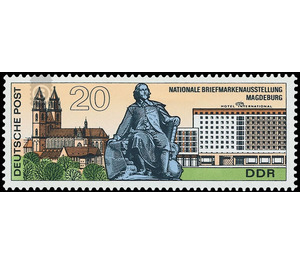National stamp exhibition 20 years GDR, Magdeburg - Germany / German Democratic Republic 1969 - 20 Pfennig
Theme: Architecture
| Country | Germany / German Democratic Republic |
| Issue Date | 1969 |
| Face Value | 20.00 |
| Color | multi-colored brown |
| Perforation | K 13:12 1/2 |
| Printing Type | offset |
| Stamp Type | Postage stamp |
| Item Type | Stamp |
| Chronological Issue Number | 1255 |
| Chronological Chapter | GER-DDR |
| SID | 16434 |
| In 17 Wishlists | |
National Stamp Exhibition 1969 in Magdeburg In the period from October 31 to November 9, 1969, a National Stamp Exhibition will be held in Magdeburg for the 20th anniversary of the German Democratic Republic. On this occasion, the Ministry of Postal and Telecommunications of the GDR, two multicolored special postage stamps, including one with surcharge, out. The sums collected will be made available to the Philatelist Association of the GDR in the German Cultural Association. Magdeburg - host of the National Stamp Exhibition 1969 Magdeburg is not only the center of heavy machinery construction in the GDR, but also a city of education and culture. From October 31 to November 9, 1969, this modern socialist city, newly created from the inferno of the Second World War, will host the National Stamp Exhibition "20 Years DDR". The organizer of this great performance show of the philatelists of the GDR is the Philatelistenverband der DDR in the German Cultural Association, founded on 19 April 1969. With 620 registered objects and more than 52,000 album pages, this exhibition is the largest philatelic exhibition to date in the GDR. The special postage stamps issued on the occasion of this exhibition reflect the more than 1,000 years of history of the Elbe city. The 20 pfennig mark goes a long way from the early Middle Ages to our days and bears witness to the eventful history. Cathedral - Monument Otto von Guerickes - Hotel International are three landmarks of Magdeburg. The Cathedral of St. Maurice was built between 1209 and 1520 in several phases on or around the plan of the old Ottonian building of the Benedictine monastery church of 937. The towers are 103 and 105 m high, the length of the cathedral is 120 m. This historic cultural monument of Gothic architecture is a three-nave basilica with four-part ribbed vault, polygonal chancel and chapels and a double tower facade. On the south side of the nave are cloister and cloister buildings. Many treasures of architecture and sculpture can be seen in the cathedral. In 1944 and 1945, Anglo-American air mines damaged large parts of the bell tower and the two side aisles. The restoration of the cathedral, for which our state has spent over 2.5 million marks so far, is one of the great achievements of the preservation of our socialist state. Since 1957 this cultural-historical precious building can be used again for church services. The Otto von Guericke monument on the northeastern part of the Old Market was built in honor of the great son of the city of Magdeburg, councilman and mayor, diplomat, architect, explorer and inventor. Otto von Guericke (1602-1689) was Mayor from 1646 to 1681 and represented the interests of 1631 in the Thirty Years War completely destroyed city Magdeburg with dignity and prudence against the princes and even the emperor. The monument is also reminiscent of the great master builder, who considered the modernization of the town quite a modern one to be a generous loosening of the old medieval road network. In front of the monument, the viewer is also reminded of the pioneering researchers and physicists, who became famous and famous for his "Experimenta nova Magdeburgica de vacuo spatio" (New Magdeburg Experiments on Vacant Space). Otto von Guericke is the inventor of the air pump and was able to demonstrate his experiments with the "Magdeburg hemispheres", which were vacuum-pumped, could not be torn apart by 16 horses, at the Reichstag in Regensburg. He continues to be the inventor of the barometer and pioneered modern meteorology and weather forecasting. In old age he had to learn ingratitude, incomprehension and backwardness, so that he left the council and left his native city. With the technical college "Otto von Guericke" our socialist state has set a worthy memorial to this famous Magdeburg. It is part of the tradition that, at Guericke's monument, the newly-crowned doctors of the Technical University receive their doctorate after old ceremonial. Interhotel International - the last presentation on the mark to 20 Pfennig shows the new, socialist Magdeburg. On July 27, 1963, the first new hotel building in the GDR opened its hospitable premises. Meanwhile, in the 365 rooms of the eight hotel floors over 675,000 guests from 88 countries on all continents of our globe got to know the good gastronomy of the GDR. With a wide range of services, a service center, an inter-hotel shop, well-kept restaurants, a café and a bar, Interhotel International is part of the Interhotel Association. The guests of the National Stamp Exhibition will feel at home in this house.


